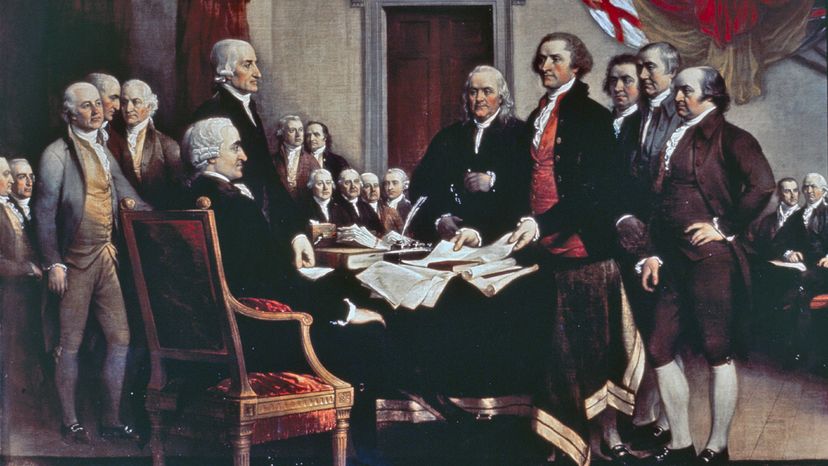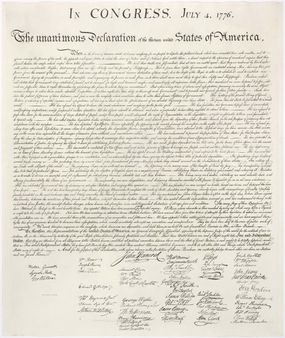Audience Of Declaration Of Independence

Abraham Lincoln knew exactly why the Declaration of Independence was such a profoundly important political document.
"I have never had a feeling politically that did not jump from the sentiments embodied in the Announcement of Independence," said Lincoln in an improvised speech on the eve of his starting time inauguration. "I take ofttimes inquired of myself, what great principle or idea it was that kept this Confederacy and then long together. Information technology was not the mere matter of the separation of the Colonies from the motherland; but that sentiment in the Declaration of Independence which gave liberty, not alone to the people of this land, only, I promise, to the world, for all future time."
Lincoln was one of many American leaders and civil rights activists who challenged the nation to alive up to its founding principles as enshrined in the Proclamation of Independence, "that all men are created equal and endowed by their Creator with sure unalienable Rights, that among these are life, freedom and the pursuit of happiness."
Simply in that location'southward much more to the Annunciation of Independence than that i unforgettable sentence. In 1,337 words, Thomas Jefferson and the residuum of the Continental Congress made the case to their fellow Americans and the earth that they had suffered abuse and mistreatment under King George III and that the British parliament intended to have away their freedoms. Colonists had no option but to cut ties with Great britain and declare themselves "gratis and independent states."
What's Inside the Declaration of Independence?
The Annunciation of Independence is organized into five main sections. First comes the introduction, a paragraph-long judgement that sets the stage for the philosophical arguments to come and places the call for independence in the broader "grade of human being events" as "necessary" under the "laws of Nature."

National Athenaeum
Then comes the preamble, which begins with those immortal words, "We concord these truths to be cocky-axiomatic, that all men are created equal... " and manages, in just 5 sentences (202 words), to lay out the entire American philosophy of government. Namely that "but" governments derive their powers "from the consent of the governed," and that the people have the correct to organize their government based on principles that "shall seem nigh probable to effect their safety and happiness."
The third and longest section of the Annunciation is the list of grievances confronting George III, who Jefferson boldly labels a "tyrant." Modeled after much older founding English language documents similar the Magna Carta (1215) and the Petition of Right (1628), this lengthy indictment of the king's various abuses confronting the natural rights of the colonists lays down the "facts" of the case for independence.
The next, much shorter section extends the male monarch's indictment to the British people, who had ignored the pleas of their "common kindred" and been "deafened to the vocalization of justice." For that reason, the Americans had no option but to consider their former countrymen "enemies in state of war, in peace friends."
The final section or conclusion wraps upwards the colonists' case in largely formulaic language common to political documents. Only information technology ends with an emotional zinger that rings through the ages: "And for the support of this Declaration, with a firm reliance on the protection of divine Providence, we mutually pledge to each other our lives, our fortunes and our sacred laurels."
One Document, 4 Audiences
The Declaration of Independence was written for several audiences with distinct political stakes in the fledgling nation, explains John Kaminski, director of the Center for the Study of the American Constitution at the University of Wisconsin-Madison.
The outset audience was the American people, who remained divided between Loyalists and Patriots. The Declaration argued the cause of independence was just and that the price of freedom was ane that Americans should be willing to pay.
The 2d audience was U.k., both its people and its government. Equally its name implies, the Declaration of Independence wasn't request for permission to sever ties with the mother land — information technology was declaring independence, i.eastward. "this is happening and this is why nosotros're doing it."
The third audition was less obvious and consisted of every land that had a beef with England. Kaminski says that France and Spain in detail had "nifty grievances" against Bully Britain and expected to go to war with King George any mean solar day.
"One of the things that France and Espana were worried about was to enter into some kind of military alliance or commercial alliance with the Americans only to watch them go dorsum and reconcile with Great Britain," says Kaminski. "France and Kingdom of spain wanted to see a severance, and the Annunciation of Independence was an announcement to them we're no longer with Neat United kingdom of great britain and northern ireland. It'southward over."
The fourth audience was posterity. The Founding Fathers knew they were writing a somewhat radical document that had the potential to launch an entirely new kind of democratic enterprise.
"They were writing to us in the hereafter,"says Kaminski. "They wanted to show what motivated them and why they took this drastic activeness."
If 'All Men Are Created Equal,' What About Slavery?
To modernistic readers, this is one of the most glaring inconsistencies of the Annunciation, that the Founders could claim that "all men are created equal" while allowing the practice of slavery and denying basic civil rights to black people and women.
To 18th-century readers, though, at that place wouldn't have been such a conflict, says Kaminski. They would accept understood that Jefferson was writing philosophically. In other words, all men and women are created equal in the eyes of God, fifty-fifty if they're non equal here on Earth.
Jefferson might have also been speaking on a societal level, comparing Americans as "equal" to "all [other] men." At least that's what Jefferson was getting at in the introduction when he asserted that "amid the powers of the Globe," the colonists occupied a "split and equal station."
Interestingly, 19th-century Confederate secessionists took Jefferson at his discussion, assertive that the Founders meant that all men, including free and enslaved blacks, were created equal, and that's why the South had to split from the Spousal relationship.
Was Jefferson the Sole Writer of the Declaration?
On June vii, 1776, a "Committee of 5" was tasked with drafting the Declaration of Independence: Roger Sherman, Benjamin Franklin, Thomas Jefferson, John Adams and Robert Livingston. Once they agreed on the substance of the document, they debated over who should write the first draft.
Jefferson wanted Adams to do it, merely the Massachusetts delegate refused in his typical colorful fashion. In an 1822 letter of the alphabet, Adams recounted how he convinced Jefferson to practise it.
"Reason first, you are a Virginian, and a Virginian ought to announced at the head of this business. Reason second, I am obnoxious, suspected and unpopular. You are very much otherwise. Reason third, you can write 10 times meliorate than I can."
What Was Cut From the Declaration of Independence?
Jefferson's original typhoon, written over three weeks holed upward in his Philadelphia boarding house, went through heavy edits past the Continental Congress. In Jefferson'south draft of the preamble, he held these truths to be "sacred and undeniable," not "cocky-evident." And the Founders added that shoutout to "divine Providence" in the final line.
But the biggest and well-nigh glaring alter was the deletion of an entire lengthy paragraph about the Atlantic slave trade. Jefferson, who one scholar calls "maddeningly complex" on the issue of slavery, berated Rex George for refusing some colonists' calls to rein in or terminate the slave trade from Africa.
"He has waged vicious war against human being nature itself," wrote Jefferson in his original draft, "violating information technology's [sic] about sacred rights of life & liberty in the persons of a afar people who never offended him, captivating & conveying them into slavery in another hemisphere, or to incur miserable decease in their transportation thither."
Adams particularly loved this department of Jefferson'due south draft, but knew it would cease upwardly on the chopping cake.
"I was delighted with its high tone and the flights of oratory with which it abounded, specially that concerning Negro slavery, which, though I knew his Southern brethren would never suffer to pass in Congress, I certainly never would oppose," wrote Adams.
A Declaration Heard Circular the World
The Declaration of Independence was not signed on July 4, 1776, as is ofttimes idea. The 2d Continental Congress voted to approve the resolution to legally separate from Smashing Britain on July 2. Just the document was printed on July 4, so that's the appointment on the Declaration.
As Lincoln said, the Declaration of Independence is more than an American document; it'south a declaration of liberty shared by all gratis people. Since 1776, there take been 120 declarations of independence issued by nations and other sovereign peoples.
Jefferson hoped that this would be true when he wrote a friend in 1795: "This ball of liberty...is now so well in motion that it will roll circular the globe. At least the enlightened part of information technology, for light & freedom get together."
Audience Of Declaration Of Independence,
Source: https://history.howstuffworks.com/revolutionary-war/declaration-independence.htm
Posted by: glessnersopland.blogspot.com


0 Response to "Audience Of Declaration Of Independence"
Post a Comment